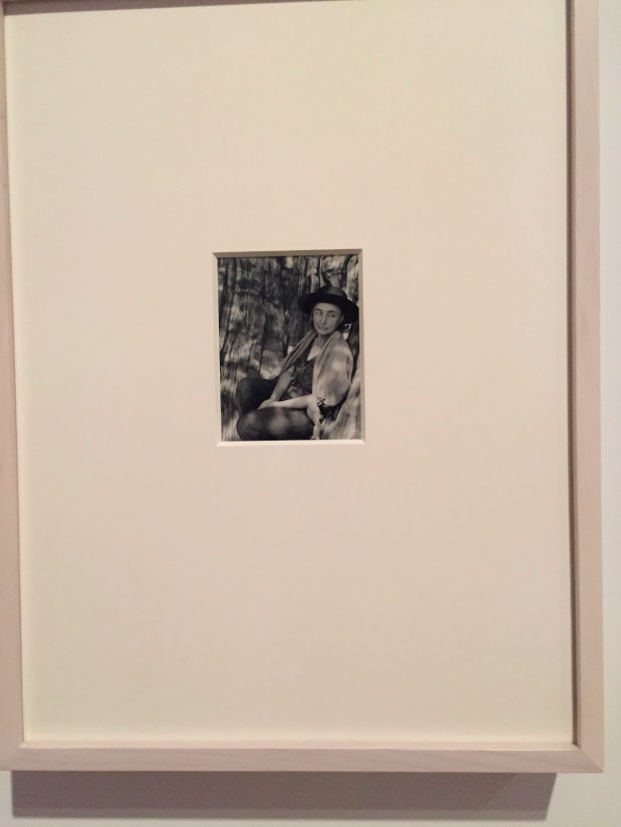Review: Georgia O’Keeffe - Living Modern @ the Brooklyn Museum
“A girl who doesn’t give a cent for men and boys still less.”
This month I went to the Brooklyn Museum and saw the exhibit Georgia O’Keeffe: Living Modern.
I went without any prior knowledge about the exhibit, expecting to find paintings, maybe a couple photos and pieces of memorabilia. When I arrived and found that her clothes were a main feature, especially in regards to her work, relationships, and where she was living, I took out my notebook and snapped a few photos.
Georgia O’Keeffe was an active member of the Arts and Crafts Movement - that is the movement of using traditional and simple craftsmanship to create romantic, folk-like and medieval decor, expressing economic and social reform, rejecting industrial ideals.
Much like her fellow peers, Georgia O'Keeffe participated in the movement by designing, creating, wearing and maintaining her clothes. A particular exhibit of note: one of her dresses on display had been worn for over 50 years.
Skilled craftsmanship was essential to creating clothes that were not only intricate and beautiful, but also withstood the tests of time. O’Keeffe mended her clothes when needed, and that ensured the longevity of these unique pieces - a far cry from our current throw away culture.
Knowing how to re-enforce a strap, or sew on a button, or hem a pair of pants belong to a set of skills that can not only extend the lifespan of loved pieces, but also save money!
Visiting the exhibition gave me the chance to reflect on modern day culture. I personally find it very empowering to know that I can sew on a patch, or use a seam ripper to open pockets. Often, lots of pockets are loosely sewn shut to protect the lining of the pocket. Those of us that shop in the women’s clothing departments know the struggle of fake pockets - I used to laugh at my mother when she said “pockets have power” but now I know she was speaking the truth!
While Georgia O’Keeffe was involved in a movement that was already established and well known, that did not stop her from becoming a key founder of a new way of thought, and art: American Modernism. Georgia O’Keeffe is often referred to as the “Mother of American Modernism.”
Recognisable for her abstract representation of flora, rocks, seashells and other natural fauna, she established herself as a pioneer, continuously challenging the boundaries of the American artistic style.
Clam and Mussel - 1926
Within the exhibit, art and clothes from when O’Keeffe was living in NYC were featured side by side. The contrast between her clothes and her art was surprisingly noteworthy. Her pieces had distinct lines and shapes. They were colorful, clean and crisp.
Even although it is all too easy to keep pieces that are so sharp very flat and dull, Georgia O’Keeffe still managed to add depth, highlights and shadows without muddying the colors. If one were to look at either only her clothes or her art, when introduced to the other element, it would be hard to believe they came from the same artist. Four dresses were featured in the room with the painting shown above. They were all off white / cream / ivory, had collars of some sort and did not have a lot of shape.
It could be compared to that friend that only has yoga pants. No jeans, no khakis, no capris or cropped trousers. Just yoga pants. This was the first of two rooms that featured intricate dresses designed, sewn, cared for and worn by Georgia O'Keeffe that were all some form inspired by tunics. These four dresses would wash her out, and despite being made from silk and crepe, and being beautifully stitched, they appeared lumpy and unshaped - a striking juxtaposition against "Clam and Mussel."
Manhattan - 1932
On the opposite wall of the clothing display was a painting entitled “Manhattan” painted in 1932. This piece was a complete 180 degree turn from the dresses - the canvas depicted strong, defined lines, bold colors, elements of both nature and the city.
In the following room of the exhibit there were more examples of clothes that Georgia O'Keeffe made and wore: this is one of three shirts that caught my eye.
The shirts were all white and collared. The sewing was incredibly intricate, with lots of pleats and details. The level of craftsmanship in the clothing displayed matched the skill level of her paintings and sculptures, showing the range of different art forms she excelled in.
A Portrait by Ansel Adams
The exhibition rooms thereafter detailed her life in New Mexico. Her style adapted from detailed and well-kept garments to more practical pieces like Levi jeans and flannel shirts. In the New Mexico portion of the exhibit, I could only identify one piece of clothing she made: a red plaid dress.
Two portraits by the legendary photographer, Ansel Adams, were proudly on display. Most visitors flocked around the photo that featured Georgia O’Keeffe surrounded by animal skeletons - a visual theme that reappears in her paintings since the move to the desert.
However, the portrait that caught my eye was a bit more subdued. It shows O’Keeffe at Yosemite National Park in California, sitting by the famous Red Wood trees. It is a small picture, smaller than an index card, and yet the details - the lines, shadows, contrast, definition - are simply extraordinary.
Georgia O'Keeffe - An Intimate Invitation
Not often are there exhibits that feature intimate aspects of an artist’s life that go unnoticed; in this case, O’Keeffe’s wardrobe. If you are in Brooklyn, NY I highly suggest you check out the exhibit at the Brooklyn Museum to explore this fascinating insight into one of American Modernism's most influential women.
Georgia O’Keeffe: Living Modern is showing until July 23, 2017.











